Plextor M5S 256GB Review
by Kristian Vättö on July 18, 2012 3:00 AM ESTRandom Read/Write Speed
The four corners of SSD performance are as follows: random read, random write, sequential read and sequential write speed. Random accesses are generally small in size, while sequential accesses tend to be larger and thus we have the four Iometer tests we use in all of our reviews. Our first test writes 4KB in a completely random pattern over an 8GB space of the drive to simulate the sort of random access that you'd see on an OS drive (even this is more stressful than a normal desktop user would see).
We perform three concurrent IOs and run the test for 3 minutes. The results reported are in average MB/s over the entire time. We use both standard pseudo randomly generated data for each write as well as fully random data to show you both the maximum and minimum performance offered by SandForce based drives in these tests. The average performance of SF drives will likely be somewhere in between the two values for each drive you see in the graphs. For an understanding of why this matters, read our original SandForce article.
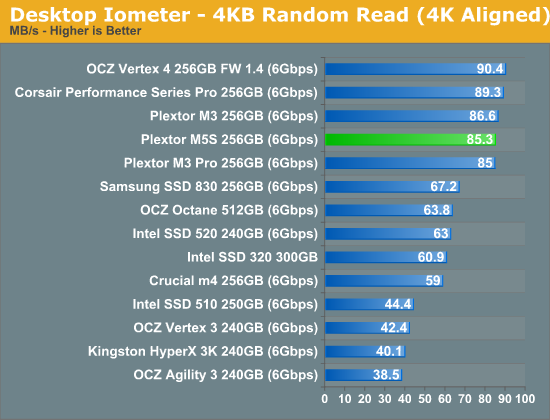
Random read and write performance has not changed at all from previous generation. This was expected because Plextor was not claiming increased random read/write performance, and the performance figures from Plextor are almost identical; The 256GB M3 Pro has 75K IOPS random read and 68K IOPS random write. The respective figures for the 256GB M5S are 73K IOPS read and 70K IOPS write.
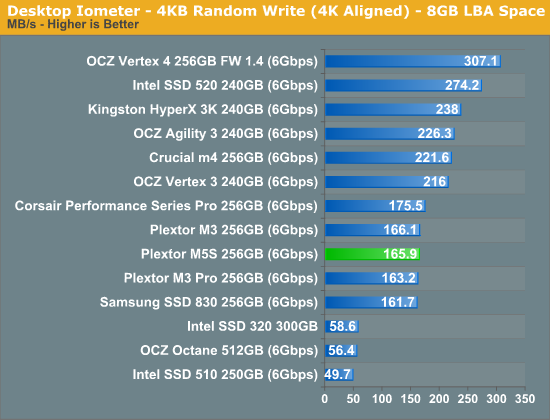
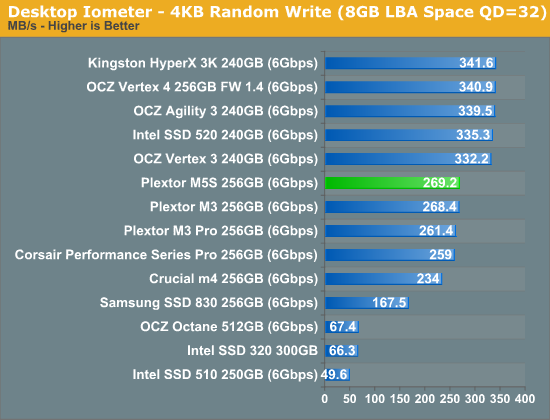
Sequential Read/Write Speed
To measure sequential performance we ran a one minute long 128KB sequential test over the entire span of the drive at a queue depth of 1. The results reported are in average MB/s over the entire test length.
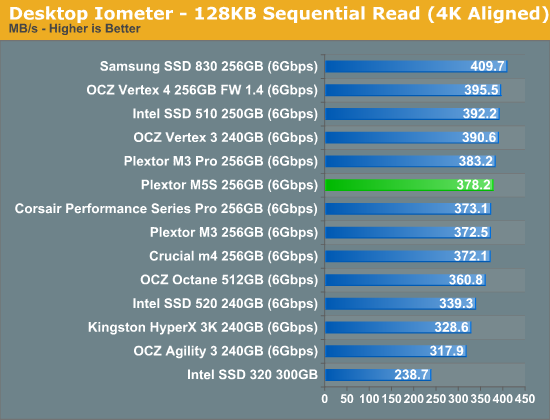
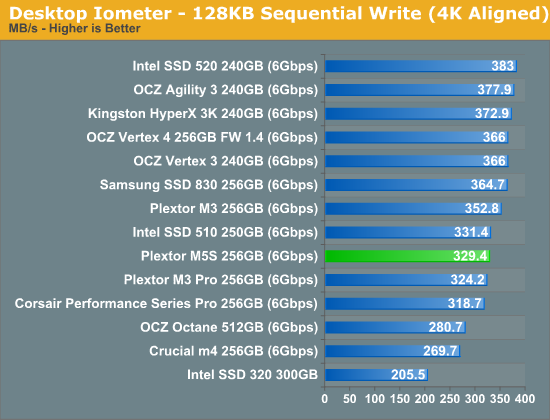
Sequential read and write performance has not changed dramatically either. Sequential read performance is right in-between the M3 and M3 Pro while sequential write performance is similar to the M3 Pro. As we discovered in our M3 Pro review, the standard M3 actually performed better in sequential write test with compressible data, although the M3 Pro was much faster when tested with incompressible data.










43 Comments
View All Comments
sulu1977 - Thursday, July 19, 2012 - link
Years ago I read that SSDs can easily last a lifetime of normal use, and if they fail, you never lose any data. Now I'm getting the feeling that they can have a higher failure rate than mechanical HDs. This is very disturbing. What's the real truth here?sheh - Thursday, July 19, 2012 - link
What worries me is the data retention period. The JEDEC JESD218A standard requires, when powered off, only 1 year of retention for Client class drives, and 3 months for Enterprise. This can be higher or lower depending on temperature. I suppose real flash exceeds that, and I suspect drives actively "refresh" stored data when they're powered on, but that's just a guess.I'd like to see an AnandTech article on SSD reliability, including retention, write endurance, trends as manufacturing processes get smaller, SLC/MLC/eMLC/TLC, etc.
sulu1977 - Thursday, July 19, 2012 - link
Just curious; how many of you would be willing to put priceless photos on a SSD and store it in a drawer for 5 years?sheh - Thursday, July 19, 2012 - link
There's a lack of info on data retention, so no.flensr - Thursday, July 19, 2012 - link
How come SSDs seem to always come in 9.5mm when that means you can't use them in many of the newer thin laptops? a 7mm drive can come with a super cheap plastic shim that would make them fit into a 9.5mm chassis, but you can never fit a 9.5mm drive into a 7mm chassis. 9.5mm is a stupid size for an SSD, period. If the SSD is put into a desktop, tower, or HTPC case then the height doesn't even matter at all, and 7mm drives can fit into any laptop using the 2.5" format, normal, slim, or even the less common 12mm height ones.Reviews ought to point out that these 9.5mm drives are totally worthless for upgrading many many laptops now that the slim drives are becoming much more common. Maybe the SSD manufacturers will figure out that there is really no reason at all to make ANY 9.5mm drives, since a simple plastic adaptor will make a 7mm drive fit snugly into a 9.5mm chassis while maintaining compatibility with many more laptops overall.
scbdpa - Thursday, July 19, 2012 - link
the m3 pro is 7mm. maybe the m5pro will be, tooggathagan - Thursday, July 19, 2012 - link
Why the vitriol?It makes you sound like a 12-year-old gamer on Xbox Live.
He states the thickness on the 3rd page of the review.
Given that there are many,many more laptops that CAN use the thicker drives, I don't know why you feel that extra attention needs to be given to that particular spec.
While it may be over the minimum thickness needed for an SSD, the size has been around ever since the laptop hard drive has existed.
I suspect that whoever 1st brought this type of SSD to market simply stuck with the same form factor and everyone else just followed suite.
I doubt a different height was even considered until notebook manufacturers started getting serious about notebook thickness and someone had a light bulb go off in their head.
flensr - Friday, July 20, 2012 - link
Why the vitriol? You prove my point completely in your post. None of your "reasons" make any sense if they put any thought into it, and a 7mm drive would fit into ALL laptops, not just "many many more". So a smart intelligent design choice would lead to compatibility with "all", rather than not thinking about it at all which leaves a growing number of potential customers with a sharply reduced set of options.Hmm. I think that just about defines "stupid" when it comes to marketing and design. Hence, my description of the design as "stupid".
As for what it "sounds like", you sound like a fanboi defending a stupid no-thought-involved design choice simply because the stupid decision doesn't impact you personally yet. You can try to explain it away all you like, but the fact remains that building 9.5mm SSDs excludes a growing percentage of the potential SSD customer base for no reason.
Making it worse, even among companies that do sell 7mm height drives, there is no standard for putting this in the specs. One or two sellers list "7mm" as a height, some go with something like "0.28 inches", and at least one simply describes their drives as "thin enough for slim profile laptops".
I'd have purchased at least 3 SSDs for my laptops by now, except that every time I start looking I find some lower-end ones listed as 7mm, some overpriced ones listed as "super slim on a diet!!!111one", and some with no thickness listed whatsoever that are out of stock yet which I know from a good review are the right size. After a while I put a "notify me" flag on one and give up. That's 3 drives I didn't purchase because the SSD manufacturers are building and marketing drives that exclude me, for no real technical reason. It is as if they don't want me to buy their drives. So I haven't yet. Maybe someday I'll go shopping for an SSD that got a good review, and it'll be competitively priced and have right in the specs "7mm height", and it'll be in stock. I'll buy right then. So far it's been a fight just to identify what size the drives actually are because they keep using the weird 9.5mm height for most drives and seem intent on hiding which drives are 7mm.
waldojim42 - Saturday, July 21, 2012 - link
Not sure what specs you need for a 7mm drive, but the M3 is 7mm and fits my W520 perfectly.JellyRoll - Friday, July 20, 2012 - link
The excuse for not disclosing the calculation method for write amplification is weak, at best.This calls into question the trustworthiness of the data. Any website that uses 'secret' methods of measurement should be called into question. Does the measurement method favor certain controllers, or types of NAND? Or does advertising revenue affect the results?